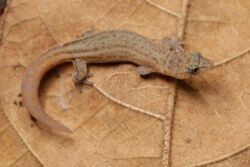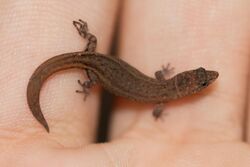Biology:Sphaerodactylus ariasae
| Sphaerodactylus ariasae | |
|---|---|

| |
| Scientific classification | |
| Domain: | Eukaryota |
| Kingdom: | Animalia |
| Phylum: | Chordata |
| Class: | Reptilia |
| Order: | Squamata |
| Family: | Sphaerodactylidae |
| Genus: | Sphaerodactylus |
| Species: | S. ariasae
|
| Binomial name | |
| Sphaerodactylus ariasae | |

| |
| Distribution of Sphaerodactylus ariasae. Inferred range in red. | |
Sphaerodactylus ariasae, commonly called the Jaragua sphaero or the Jaragua dwarf gecko, is the smallest species of lizard in the family Sphaerodactylidae.
Description
Sphaerodactylus ariasae is the world's smallest known reptile. The second-smallest is S. parthenopion, native to the British Virgin Islands. The Jaragua sphaero measures 14-18 mm (0.55-0.71 in)[3] from the snout to the base of the tail and can fit on a US 25-cent coin. It has an average weight of just 0.13 g (0.00455 of an ounce). By contrast, the blue whale is 1,600 times longer and more than 1 billion times heavier.[4][dubious ]
Geographic range
The geographic range of S. ariasae is believed to be limited to Jaragua National Park, in the southernmost tip of the Barahona Peninsula, in the extreme southwest of the Dominican Republic and nearby forested Beata Island on Hispaniola.[2]
Habitat
The preferred natural habitat of S. ariasae is the leaf litter of the forest floor of dry forests with limestone substratum.[1]
Reproduction
Taxonomy
S. ariasae was first described by Blair Hedges, a Pennsylvania State University evolutionary biologist, and Richard Thomas, a University of Puerto Rico biologist, in the December 2001 issue of the Caribbean Journal of Science.[6]
Etymology
The Jaragua sphaero's binomial name was chosen in honor of herpetologist Yvonne Arias,[5] the leader of the Dominican conservation organization Grupo Jaragua, which was instrumental in securing the environmental protection of Jaragua National Park.[7][8]
See also
- Smallest organisms
References
- ↑ 1.0 1.1 Landestoy M, Inchaustegui S, Hedges B (2016). Sphaerodactylus ariasae (errata version published in 2017). The IUCN Red List of Threatened Species 2016: e.T75605318A115485387. https://doi.org/10.2305/IUCN.UK.2016-3.RLTS.T75605318A75607639.en. Downloaded on 26 February 2019.
- ↑ 2.0 2.1 Hedges, S. Blair; Thomas, Richard (2001). "At the lower size limit in amniote vertebrates: a new diminutive lizard from the West Indies". Caribbean Journal of Science 37 (3–4): 168–173. http://hedgeslab.net/pubs/133.pdf. (Sphaerodactylus ariasae, new species).
- ↑ Caribbean Journal of Science. University of Puerto Rico at Mayaguez. doi:10.18475/cjos. http://dx.doi.org/10.18475/cjos.
- ↑ Dibben, Nicola (2002). "Interpreting Popular Music. By David Brackett. Berkeley: University of California Press, 2000. xv + 260 pp.". Popular Music 21 (1). doi:10.1017/s026114300226208x. ISSN 0261-1430. http://dx.doi.org/10.1017/s026114300226208x.
- ↑ 5.0 5.1 Sphaerodactylus ariasae at the Reptarium.cz Reptile Database. Accessed 2015-02-21.
- ↑ "Tiny gecko is 'world's smallest'". BBC: Sci/tech News. 3 December 2001. http://news.bbc.co.uk/1/hi/sci/tech/1689313.stm. Retrieved 2009-02-08.
- ↑ "World's Smallest Reptile Discovered in Caribbean". Conservation.org (Press release). Conservation International. 3 December 2001. Retrieved 2015-02-21.
- ↑ Beolens, Bo; Watkins, Michael; Grayson, Michael (2011). The Eponym Dictionary of Reptiles. Baltimore: Johns Hopkins University Press. xiii + 296 pp. ISBN:978-1-4214-0135-5. (Sphaerodactylus ariasae, p. 11).
External links
- National Geographic: Smallest Known Lizard Found in Caribbean
- At the Lower Size Limit in Aminote Vertebrates: A New Diminutive Lizard from the West Indies
Wikidata ☰ Q1938610 entry
 |



